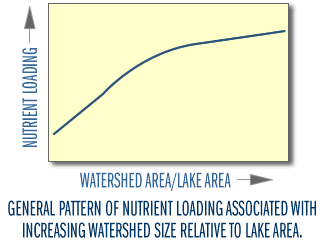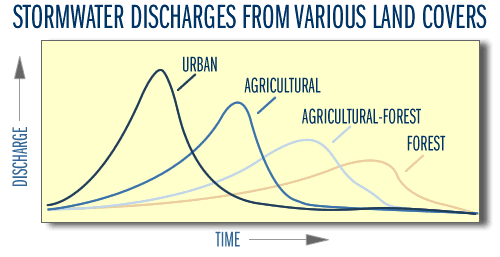 |
 |
![]()
The watershed, also called the drainage basin, is all of the land and water areas that drain toward a particular river or lake. Thus, a watershed is defined in terms of the selected lake (or river). There can be subwatersheds within watersheds. For example, a tributary to a lake has its own watershed, which is part of the larger total drainage area to the lake.
A lake is a reflection of its watershed. More specifically, a lake reflects the watershed's size, topography, geology, landuse, soil fertility and erodibility, and vegetation. The impact of the watershed is evident in the relation of nutrient loading to the watershed:lake surface area ratio (Figure 7).

Figure 7
Typically, water quality decreases with an increasing ratio of watershed area to lake area. This is obvious when one considers that as the watershed to lake area increases there are additional sources (and volumes) of runoff to the lake. In larger watersheds, there is also a greater opportunity for water from precipitation to contact the soil and leach minerals before discharging into the lake. Lakes with very small watersheds that are maintained primarily by groundwater flow are known as seepage lakes. In contrast, lakes fed primarily by inflowing streams or rivers are known as drainage lakes. In keeping with the watershed:lake area relationship, seepage lakes tend to have good water quality compared with drainage lakes. However, seepage lakes are often more susceptible to acidification from acid rain because of their low buffering capacity.

Figure 8
Landuse has an important impact on the quality and quantity of water entering a lake. As Figure 8 shows, the stormwater discharge to a lake differs greatly among landuses. In urban areas, the high proportion of impervious surfaces prevents absorbance of rainwater into the soil and increases the rate of surface water flow to the lake. The high flushing rates from urban areas can increase erosion of stream banks and provide sufficient force to carry large particles (i.e., soil) to the lake. Thus, water quantity affects water quality.
Additionally, as water flows over roads, parking lots and rooftops, it accumulates nutrients and contaminants in both dissolved and particulate form.
|
Table
3. Phosphorus export coefficients
(from Reckhow and Simpson, 1980). |
|||
|
Phosphorus (kg/km2yr) |
|||
| HIGH | MID | LOW | |
| Urban | 500 | 80-300 | 50 |
| Rural/Agriculture | 300 | 40-170 | 10 |
| Forest | 45 | 14-30 | 2 |
| Precipitation | 60 | 20-50 | 15 |
Table 3 gives representative values of export rates of phosphorus from various landuses and other sources. Phosphorus is particularly important because its availability often controls the amount of algae and the overall productivity of a lake. These values are in units of kg/km2/yr (mass of phosphorus per unit area per year). Not included here, but also important, is the influence of soil type and slope. Finer particles and steeper slopes mean higher export rates.
To clarify the relative landuse impacts, we can compare annual loads from 10 hectare (24 acre) plots of the selected landuses using the high export coefficients in Table 3.
| Forest | 4.5 kg phosphorus |
| Rural/Agriculture | 30.0 kg phosphorus |
| Urban | 50.0 kg phosphorus |
One can see that, all other things being equal, converting a forest into a city can increase the phosphorus export to a lake more than ten times. Another way to look at these numbers is that almost seven years of phosphorus loading from a forested area can be deposited within one year by mixed agriculture areas and almost eleven years of phosphorus loading from a forested area can be deposited within a year from urbanized areas. A greater loading rate puts a greater strain on the system to assimilate the nutrients.